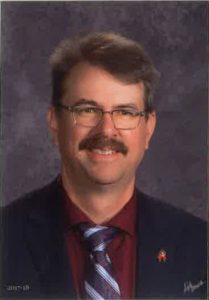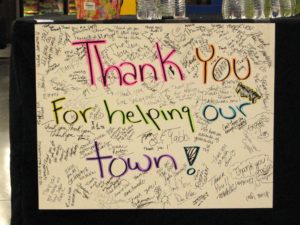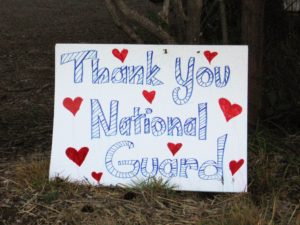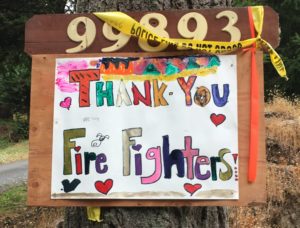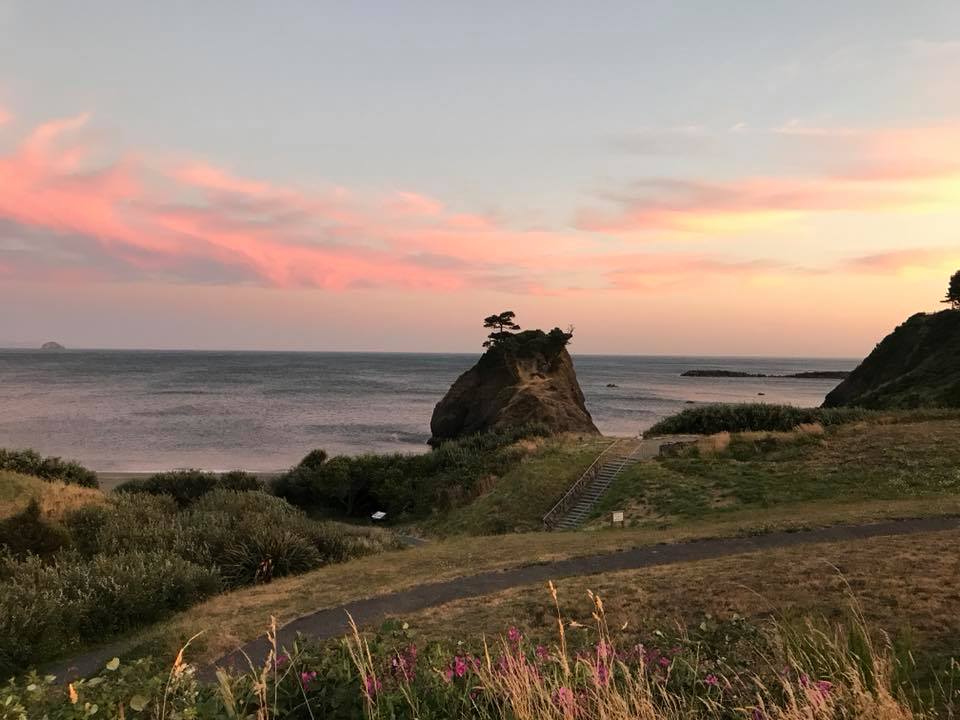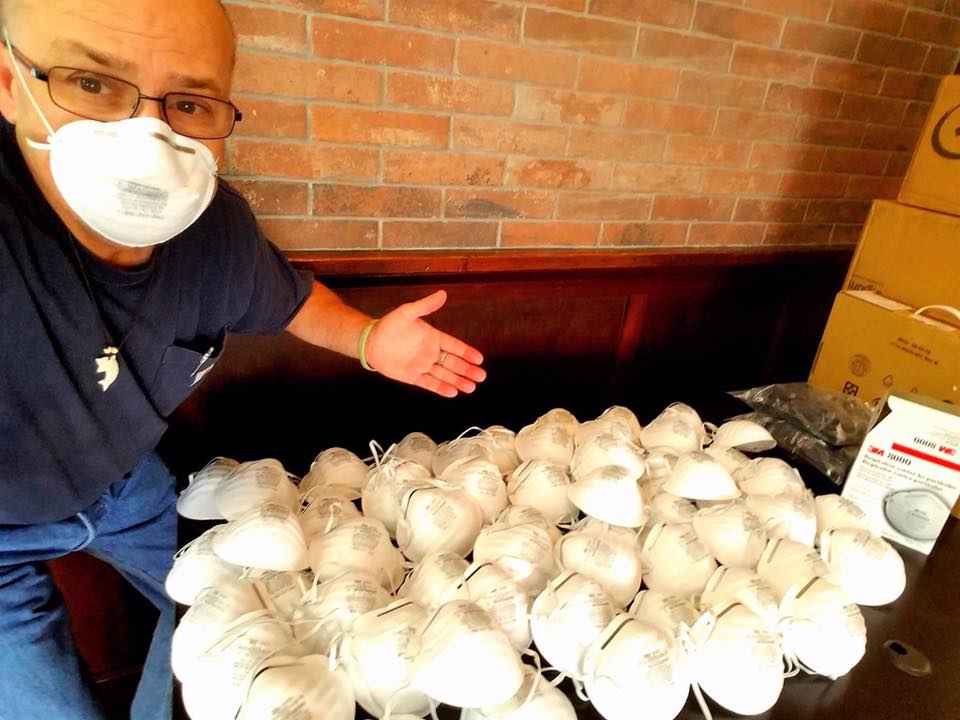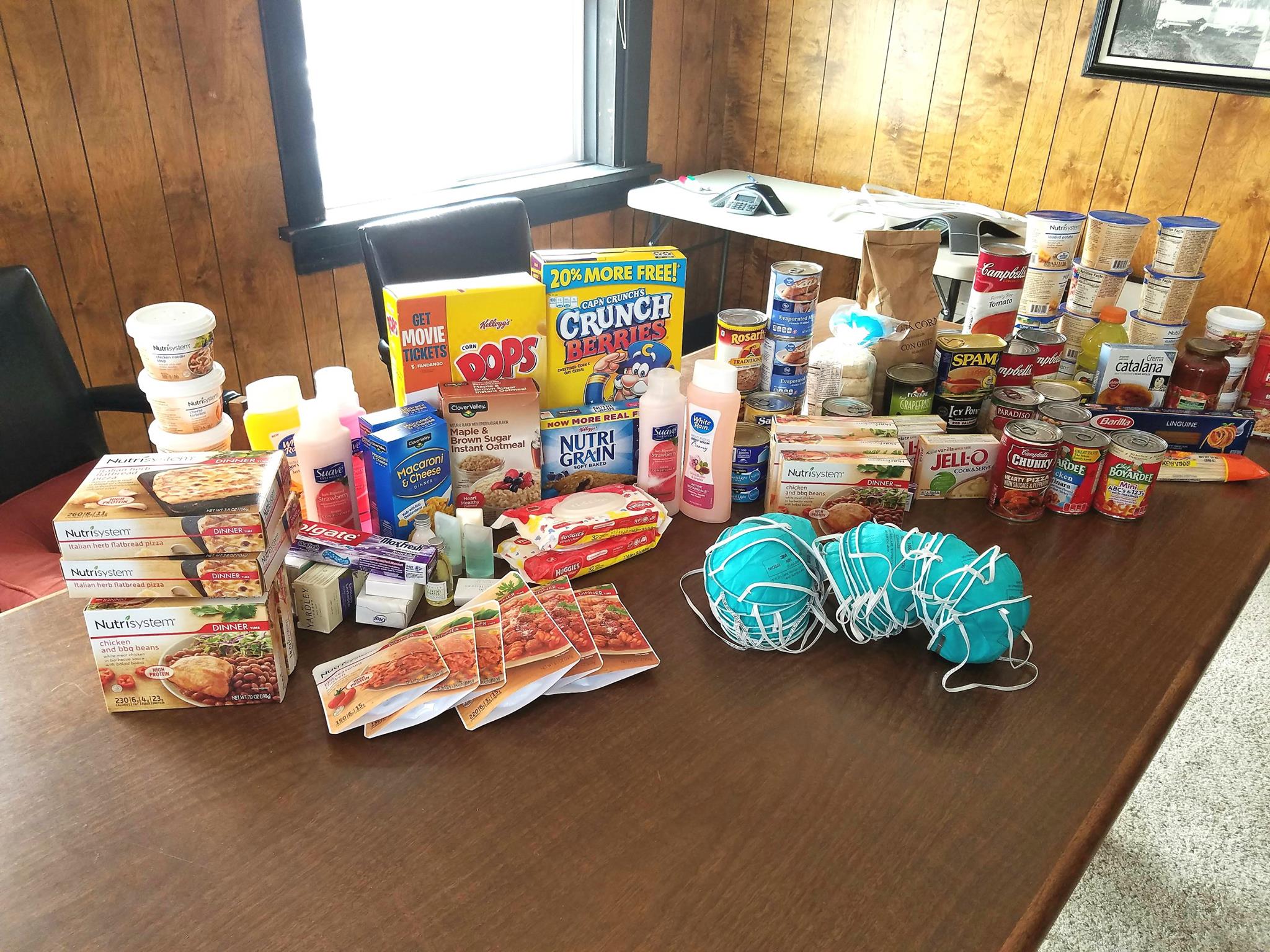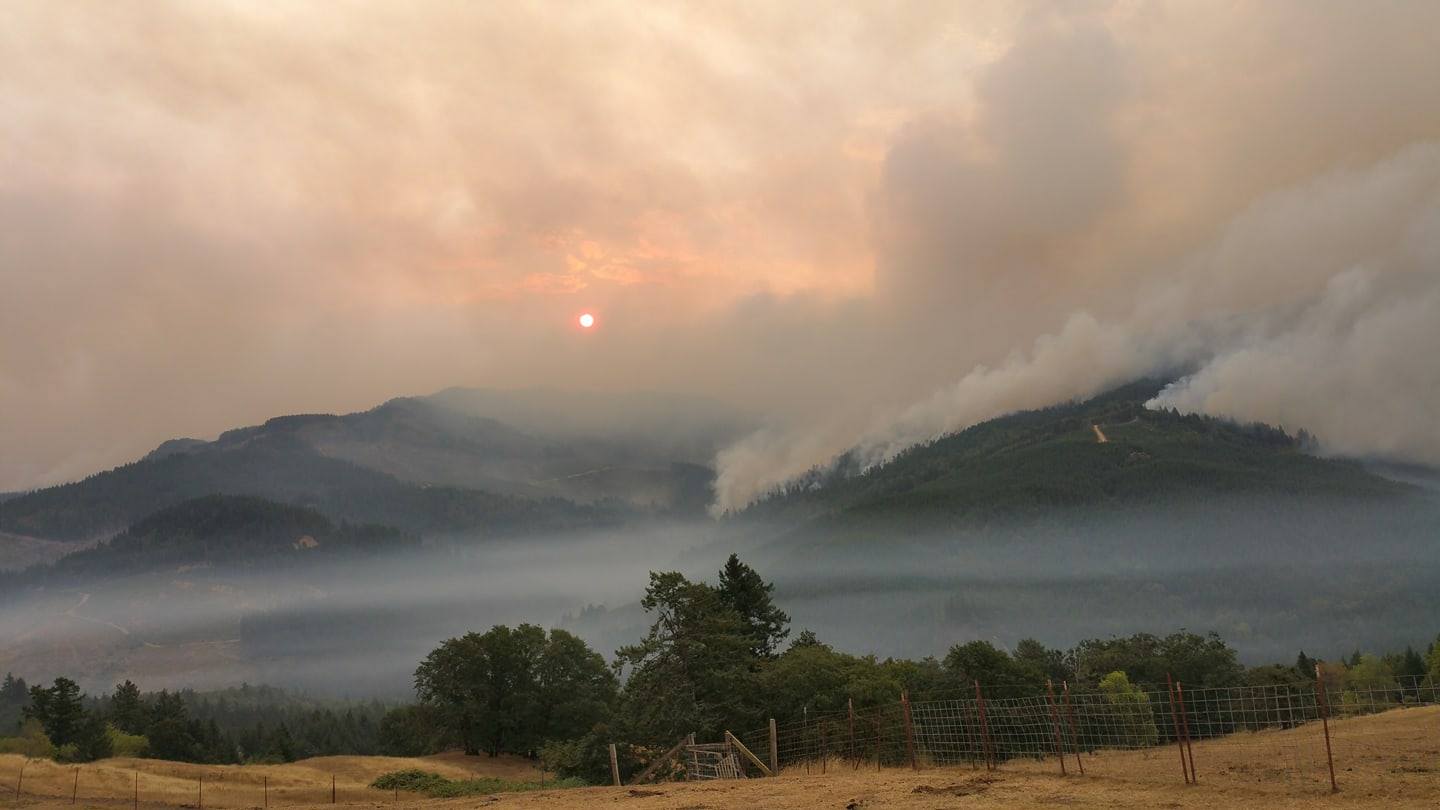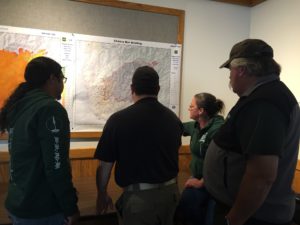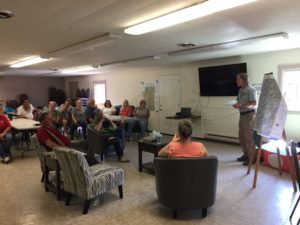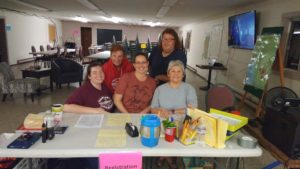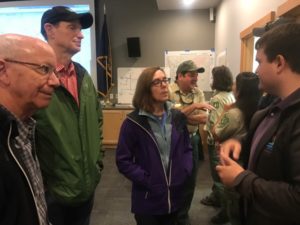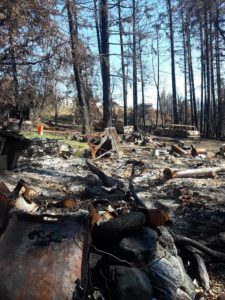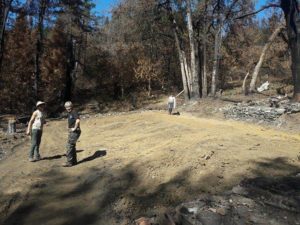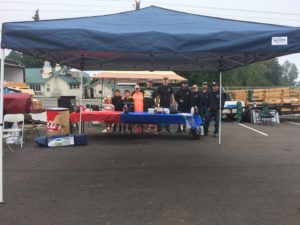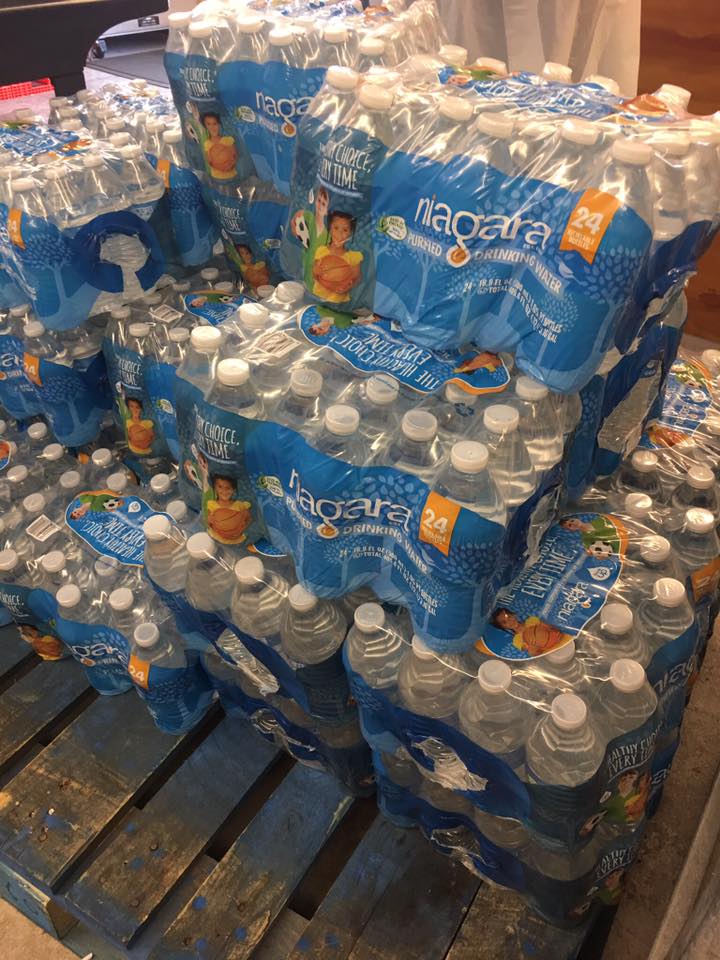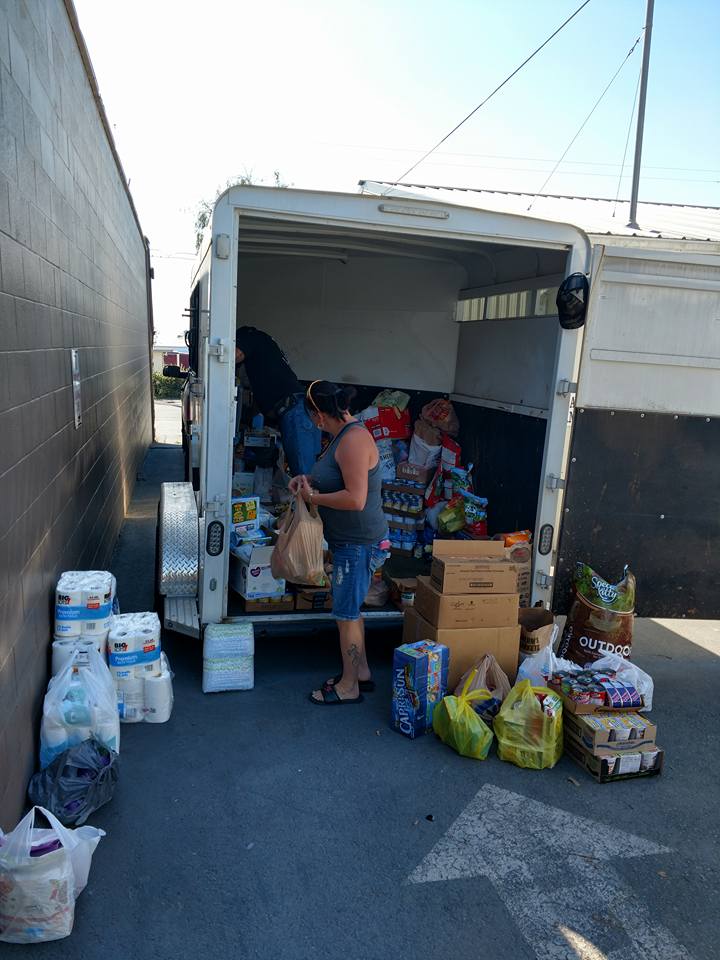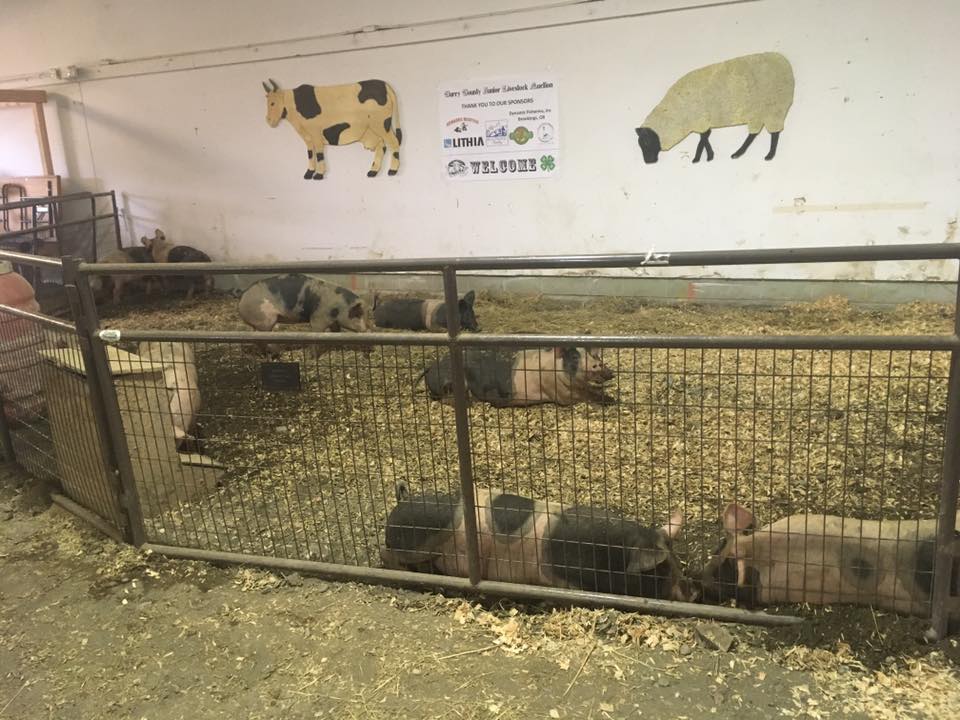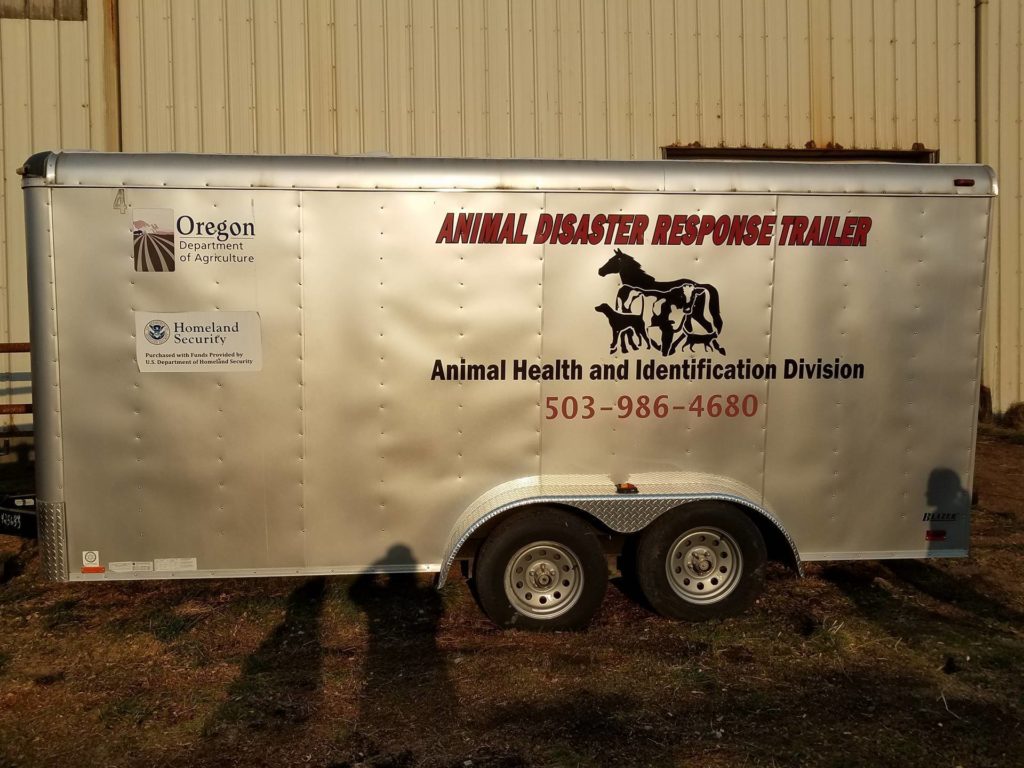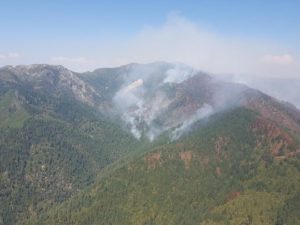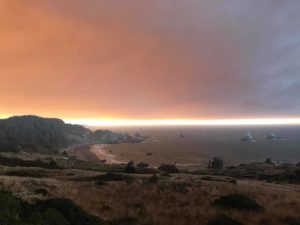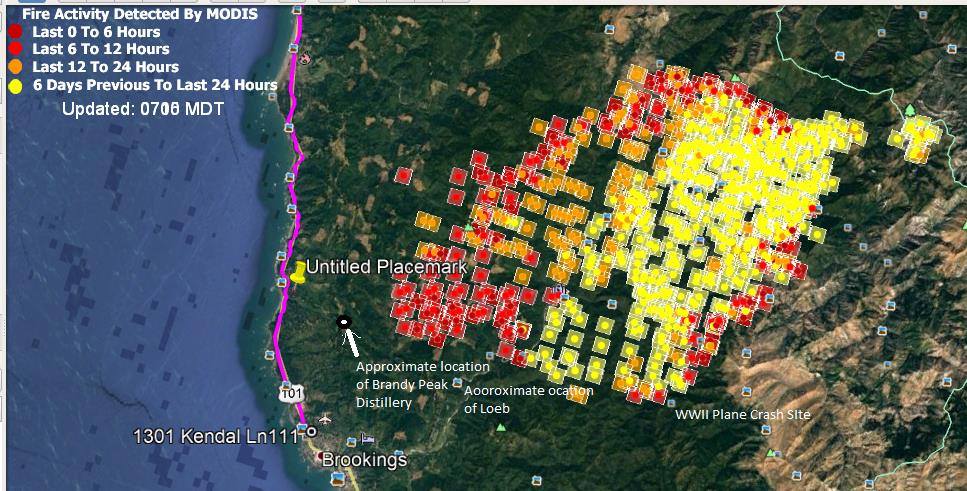Chetco Bar Fire Stories: In Conclusion
“The Chetco Bar Fire stories speak to the generosity, the spirit of cooperation in individuals, organizations and businesses, as well as the public outpouring of thanks from a grateful community.”
As we finish our presentation of the Chetco Bar Fire community stories, our 2018 fire season is well underway. The season started early with the Lobster Creek fire, which began July 1st and burned near Gold Beach. Fortunately, it was contained at about 446 acres. The Klamathon fire burned its way from California into Oregon, destroying homes. The Taylor Creek and Klondike Fires are burning currently not far to the East, and total more than 155,000 acres as of August 30th, 2018. We have had days with poor air quality; firefighters are encamped at the Curry County Fairgrounds. Total Oregon fires to date (as of August 30th, 2018) is 797 fires. Of those, 468 fires occurred in southern Oregon (Oregon Department of Forestry).
The Chetco Bar Fire stories speak to the generosity, the spirit of cooperation in individuals, organizations and businesses, as well as the public outpouring of thanks from a grateful community. It took a coming together of these groups and individuals, from 4-H members, food banks, a local tribe, schools, Facebook administrators, business owners and community members from near and far, and so many volunteers to respond to the Chetco Bar Fire.
Wildfires, storms, earthquakes, tsunamis: these are all natural disasters that can affect us at any time. They don’t even have to be that big to have an impact on many of us. The Chetco
Bar Fire series highlights stories of people working together and of efforts that went well during a disaster. But there were also many cautionary tales and gaps in communications and support systems that came into sharp relief during this project. These are areas that need to be addressed by all of us before the next big – or even not so big- one.
This, then, begs the question: how best do we not forget the lessons of the Chetco Bar Fire, as well as cherish the community spirit that brought so many people together? Here are some ideas:
1. Continue to educate ourselves and others: learn about and practice emergency preparedness for yourself and your family, as well as your business or nonprofit organization.
2. Communication is paramount: identify, build and maintain it at all levels.
3. Work on issues that already exist in our community: whether that be food insecurity, lack of housing, or drug addiction, these issues will be become a greater crisis during a natural disaster.
4. Celebrate and support the successes of our community: notice what is going well so we can learn from each other’s achievements.
5. Continue to share the stories from the Chetco Bar Fire and other disasters so we can identify the gaps and grow.
One of the sentiments we heard again and again in those we interviewed, was how moved they were by the coming together of people. The Chetco Bar Fire gave us a glimpse of a time when our community set aside differences and worked to help one another. Imagine what we might accomplish as a community if we can continue to do that.
Wild Rivers Connect would like to offer a special thanks to all the individuals who offered their time, their stories, and their pictures so we could share them in this series. We found, through the interviews conducted to write these stories, that one story would lead to another…and then another. There are so many stories of groups and individuals that we were not able to share; we encourage you to continue sharing them with each other.
Here is a complete list of the entire Chetco Bar Fire Series:
- Introduction to the Chetco Bar Fire Story Series
- Chetco Bar Fire Stories: A Safe Place for the Animals
- Chetco Bar Fire Stories: A Community Steps Up to Feed Fire Evacuees
- Chetco Bar Fire Stories: Volunteers Undertake Resource Coordination Effort
- Chetco Bar Fire Stories: The Tolowa Dee-Ni’ Nation
- Chetco Bar Fire Stories: Support from Port Orford and Beyond
- Chetco Bar Fire Stories: “Our Town Thanks You!”
- Chetco Bar Fire Stories: When Wildfire Raced Towards Our Schools
- Chetco Bar Fire Stories: Curry News & Views
- Chetco Bar Fire Stories: In Conclusion
Chetco Bar Fire Stories: Curry News and Views
Note: Jan Barbas was the sole administrator for the Facebook group “Curry News & Views”, which was where many community members turned during the Chetco Bar Fire for up-to-date and factual information about the fire. The group also had a moderating team; during the fire, it was Candi Berry; currently, it’s Bill Buchanan, Dena Nickell, and Sean Armstrong.
Recently, I was spending a lazy day at my home in Gold Beach when the emergency siren began to blare. It kept sounding and sounding. It wasn’t the regular monthly test, was it? Was it a tsunami? Or some other disaster? I logged onto my computer, clicked on the Curry News and Views Facebook Page, and immediately had my answer directly from Curry County Emergency Services Coordinator, Jeremy Dumire. No tsunami: just a routine test with the siren. I got quick, accurate information.
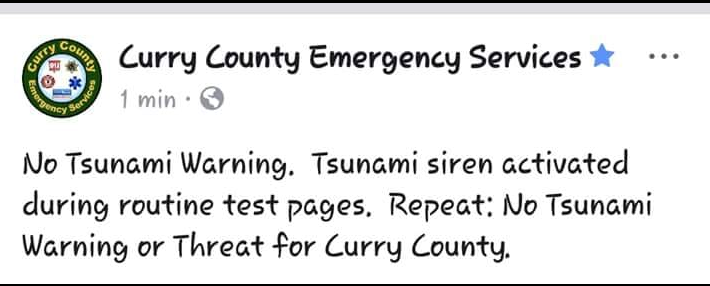
A post to CN&V from July 30, 2018.
It turns out that Curry News and Views, along with other local Facebook pages, isn’t just good for answering questions like mine; it also plays a crucial communication role for our communities, no matter what the situation. That was especially evident during last year’s Chetco Bar Fire, when Curry News & Views – and other social networking groups – kept our communities informed as the disaster played itself out.
A Go-to Place for Factual News
During the Chetco Bar Fire, Curry News & Views (CN&V) in particular saw a dramatic shift in its fundamental role. At the time of the fire, CN&V was facilitated by Jan Barbas, and grew from about 2,000 members at the start of the summer to over 4,800 by the end of 2017; the group gained approx. 1,500 members over the 5-6 week period during the worst of the fire.
“I think it (CN&V) took off during the fire like it did because we just don’t have a place through which to get daily news,” Jan Barbas said, “and since I was the admin of the group, it was a natural thing for me to post news about the fire there. There was a lot of misinformation floating around, and I just wanted to provide factual, up-to-date info as rapidly as possible.” He explained that CN&V became the “go-to” place for factual news due in part to the number of regulars who became, in essence, “citizen reporters” and who posted often.
Jan’s science-tech background helped him wade through all the information efficiently. “I was well-versed at doing the research that it took to get the correct information,” he said, “and so what I was doing on CN&V – about 60% research vs. 40% posting – just came naturally.”
“Of course, I had no idea it would become so all-consuming,” he continued, “but from the time I woke to the time I went to bed, I was focused on the fire and on updating through CN&V. I would go directly to the source – and of course, the sources changed as the fire changed – and got updates on just about everything, which I was then able to post rapidly. It just sort of took off from there!”
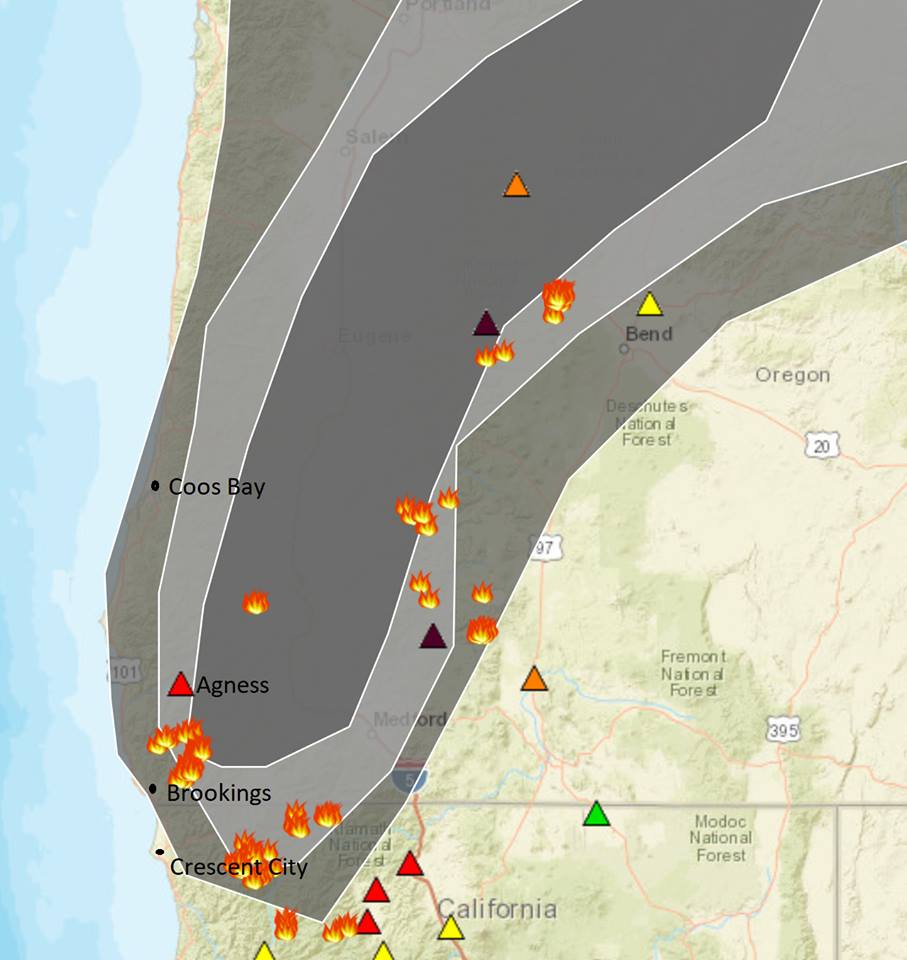
A smoke plume map posted by Jan Barbas in CN&V, August 27, 2017.
Connecting People and Resources
In addition to providing accurate and timely information, CN&V found itself connecting people with resources. They were not the only Facebook group that took on this crucial role. The Chetco Bar Fire Help Page, now the Chetco Bar Fire Help Page/Southern Oregon Fire Help Page, started by Ryan Hanners, had a primary function to connect resources to the people who needed them. Curry County Horse, Livestock, and Pet Disaster Support, started by Jessica Carrillo, took on a similar function as well, with a focus on getting people the support they needed to evacuate and care for their animals during the fire. (Read more about the animal evacuation in our first Chetco Bar Fire story: A Safe Place for the Animals.)
A lot of Jan’s time as the CN&V admin was spent connecting folks with each other. “Stuff would get posted on Curry News and Views, and I’d get it to the right people to get done whatever needed to get done,” he explained. “For instance, when Jessie G wanted to do a benefit concert, Willy Goergen contacted me through Facebook Messenger, and I put him in touch with Wild Rivers Community Foundation, who took it from there.”

A photo posted by a CN&V member requesting information on where to donate quarters so firefighters could do laundry during the Chetco Bar Fire.
Air quality became an real threat for many during the fire and Curry News and Views became an information conduit for people needing help. During the Chetco Bar Fire, the Forest Service brought in four air monitor units. But the smoke was so thick that the sensors would fail, causing the units to go off-line repeatedly.
Jan recalls smoke being an issue, “I also remember when people started reaching out to me through Messenger about the Brookings Red Cross shelter and the smoke issues there.” He continued, “for instance, a lady was evacuated from her home in Brookings because of the smoke, but she couldn’t stay at the Brookings shelter…because of the smoke! I helped her coordinate with Oasis Shelter in Gold Beach, and then with the Red Cross, once they moved their shelter to Gold Beach…just in time for this particular lady.”
The lack of clean air shelters resulted in many having to leave the area because they couldn’t breathe due to the horrible air quality; Del Norte County was able to establish some air quality shelters, but at the time Curry was not able to get that done. Today, though, Jan reports that both the Governor and Representative David Brock Smith have taken up this issue and the State is looking at how to improve response in the future.
Facebook pages also became a way for people to find evacuation information. Jan was “super impressed” by the Tolowa Dee-ni’ Nation’s efforts to help evacuees by opening up Ship Ashore for them. “They showed us the right way to do it,” Jan said, “they provided food, power, space for RV’s, WIFI, allowed pets…they took care of people’s needs first, and worried about the rest of it after.” (Read more about the Tolowa Dee-ni’ Nation’s shelter in our Chetco Bar Fire story: The Tolowa Dee-Ni’ Nation.)
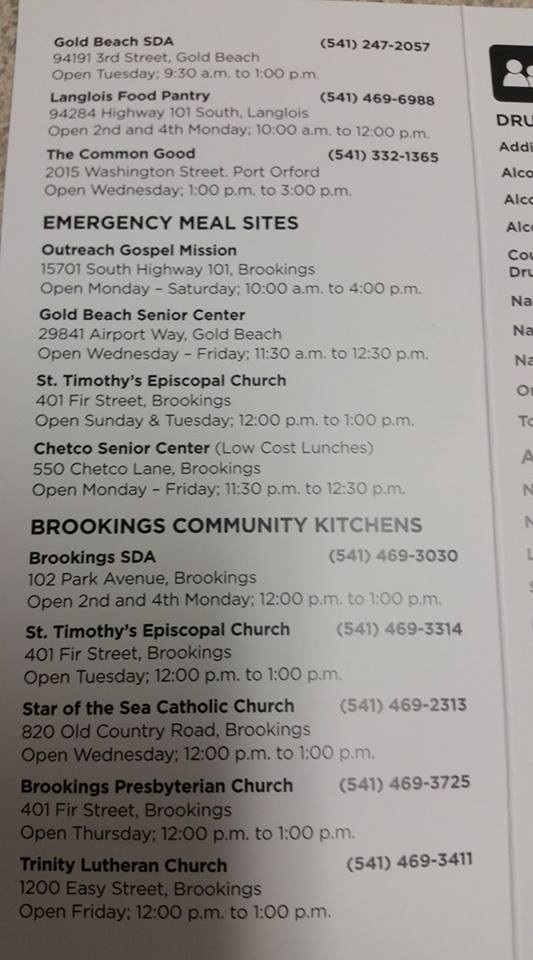
A post from CN&V member offering food resources during the Chetco Bar Fire.
People Came Together
Jan, like so many of the others we interviewed, was struck by the way people came together to help one another. Facebook groups became a platform to facilitate that coming together. CN&V morphed into one of the main places to go for information about the Chetco Bar Fire: the where, the how, and what to do to help. People just naturally gravitated toward the group because it was apparent that answers could be found there.
“It was so heart-warming,” Jan remembered, “the way people came together during the worst of it all. There were the folks who helped evacuate the animals; the people who stayed and defended property; the people who came from out of town and helped clear defensible space; the people who opened their homes for others. There was the Sheriff coordinating with the fire departments, handling the evacuations in an orderly fashion.”
Jan reflected on the fire, “we were completely unprepared for this fire. Lesson learned – we need to have a coordinated community response team in place before the next time.”
The Chetco Bar Fire has shown that social media, and groups like CN&V, will likely play a role in that response. We have already seen these groups sharing crucial information during the 2018 fire season, with updates on the Lobster Creek Fire, the Taylor Creek Fire, the Klondike Fire and others, as well as resources for people who need them.
This story was based on an interview with Jan Barbas conducted by Kathleen Dickson on March 16th, 2018. Thank you to Jan for making this story possible and for the other Facebook administrators who work to get accurate information and help to those who need it.
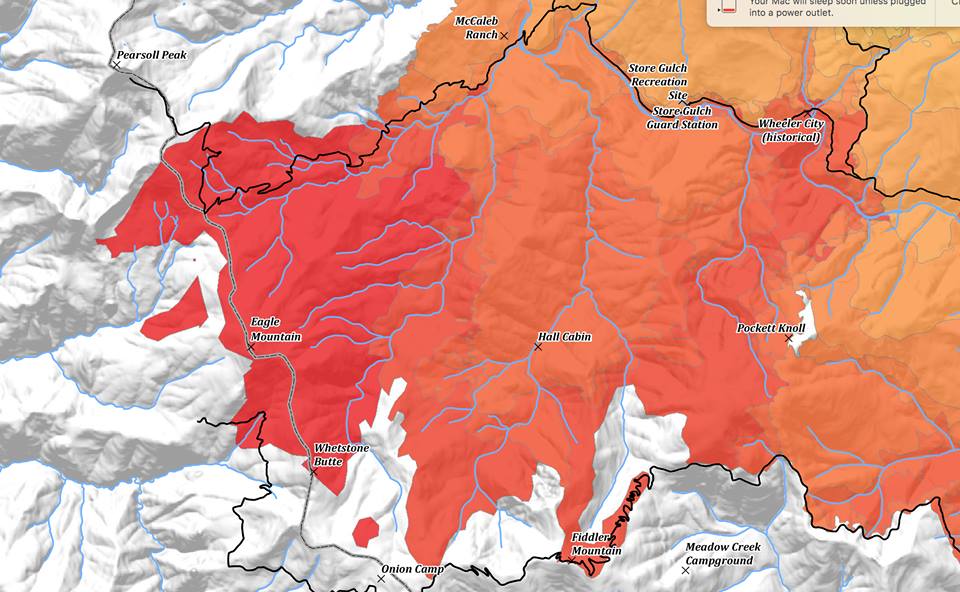
CN&V continues to be a source of local information, including posts like this, of the 2018 Klondike Fire progression map.
Chetco Bar Fire Series: When Wildfire Raced Toward Our Schools
When wildfire raced toward our schools: Evacuations, school delays, air quality concerns and putting the community first
Recollections of the Chetco Bar Fire from Superintendent Sean Gallagher, Brookings-Harbor School District 17C
On the long drive home from a regional superintendent’s meeting in mid-August 2017, Superintendent Sean Gallagher’s cell phone began to ring nonstop. “I had to pull over multiple times to take urgent calls,” he recalled.
A dire situation was developing. As he raced toward home on Highway 101, an inferno was exploding toward the community of Brookings-Harbor.
The Chetco Bar Fire, which had simmered for more than a month deep in the Kalmiopsis Wilderness with little notoriety, had suddenly exploded in size due to strong hot, dry and windy weather conditions known locally as the “Chetco Effect.” What had been 20 miles away, was quickly encroaching on town — cutting the separation to 5 miles — jumping ridges and gobbling more than 100 square miles of dense forest and vegetation along the way.
By the time Supt. Gallagher reached home, an apocalyptic cloud of smoke covered the quaint beach town and harbor — with a pall extending far out over the Pacific Ocean. Burning leaves and ash rained down. Evacuation orders were updating hourly as residents living upriver and in the hills above town were urged to leave immediately (Level 3 – Go!).
Ultimately, the firestorm would bring fear, excitement, long-term evacuations and many needed adjustments for the school district. In the coming days, the schools would serve as a Red Cross Emergency Shelter, the home of a major incident command fire camp with 500 personnel staying on the school grounds, host to numerous community fire information meetings and even a press conference for Oregon Gov. Kate Brown.
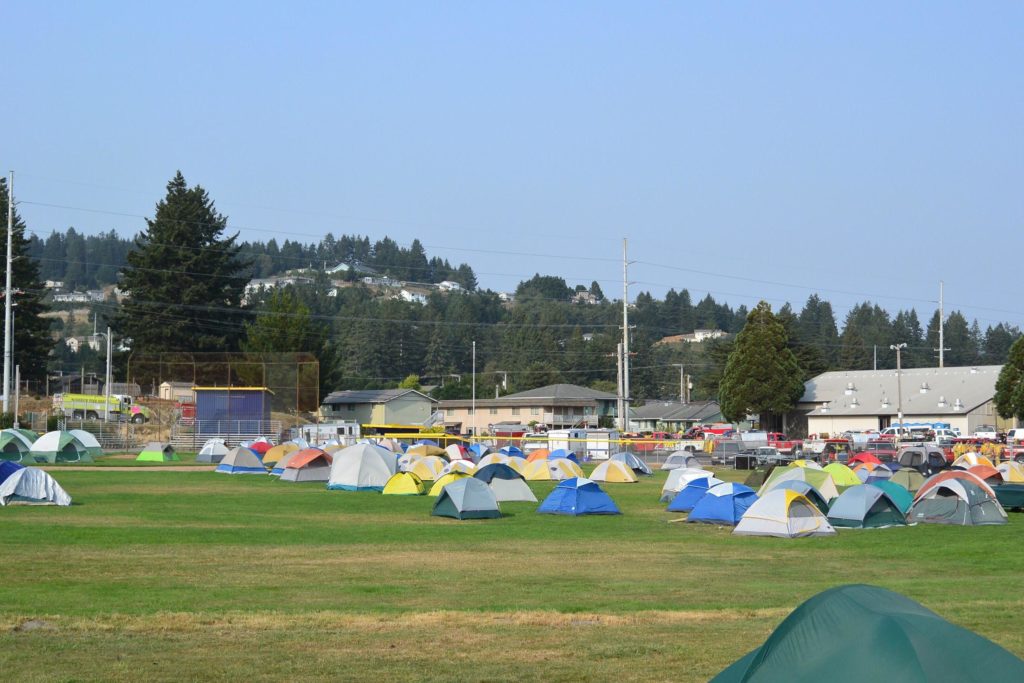
Image: Fire team tents filled athletics fields at the Brookings-Harbor School District in August 2017. More than 1,000 personnel for wildland and structural fire crews representing nearly every town and county in Oregon and other communities across the West drove through the night to reach Brookings in time as the fire exploded in size during the August 18-23 weekend, just before the 2017 total solar eclipse. They stayed for weeks to months, establishing three major fire camps. (Nancy Raskauskas-Coons/BHSD 17C)
Incident Command Meetings
Gallagher recalled, that by the time he arrived in Brookings that day, the Red Cross had already set up a shelter on school district property and supplies were starting to roll in. The school district is an emergency management center for the Brookings-Harbor community where Red Cross or emergency services can use the facilities in the event of a fire, tsunami, earthquake or other natural disaster.
Soon the town was filled with wildland fire crews and structural fire crews from all across the state and nation — an impressive amount of organizations and resources to keep track of and coordinate.
“Looking back, if I could pick out one key decision that helped guide our schools through the situation that unfolded, it was the opportunity to be part of daily unified command meetings about fire operations. I woke early and attended these briefings each morning, and was sometimes called to urgent or emergency briefings during the day,” Gallagher said.
The incident command meetings involved representatives from local emergency management services, city, county, state, and federal agencies.
“Everyday was a new day, a new twist, and being in the room with the fire command kept me in the loop with the most current information. I would meet with our school administration and directors team immediately after to share out the information. This advance intel helped us to make the right decisions as we grappled with a situation no textbook or staff training had prepared us for. It is amazing what a unified team can accomplish together in the best interest of our students and the community,” Gallagher reflected.
During the uncertain early days of the fire calamity, Gallagher and the school district leaders focused on their purpose as a public school district to first educate students, while recognizing that sometimes providing support to the overall community takes priority as the way to best support these educational goals.
“‘Other duties as assigned’ was the phrase that comes to mind as I reflect upon this moment for all involved — there were important roles and tasks that needed to be filled and accomplished,” Gallagher said.
The Multiple Roles of a School District
On the day the fire erupted, and people began to be displaced, a Red Cross Emergency shelter was set up on school grounds. However, within 24 hours, the Red Cross elected to move the shelter north to the community of Gold Beach, 30 miles up the coast due to concerns that Brookings and Harbor proper might be in eminent danger.
At this point, the event became very real. Gallagher began to grow concerned for the ability to function as a school district to support the community. “I remember spending a night at my house dealing with smoking embers falling out of the sky on my house, yard, and street,” he said.
Even with that threat, the school grounds were still one of the best areas available as a staging ground for the initial fire camp with its large open area and the ability to park EMS vehicles, pitch tents, and take showers. The district provided conference call communications rooms, centralized command facilities, bedding centers, shower facilities, and transportation shuttles to food service staging areas that fed the firefighters twice a day. The other half of the firefighters that initially surged into the community set up in the parking lots of the harbor and marina.
Gallagher found himself helping to manage and run a fire camp in coordination with State Fire Marshall, who he said did an outstanding job of maintaining their own operations including communications, coordination, and outreach.
The firefighters that the district hosted on campus were professional and polite – great role models for students, according to Gallagher. Many of them told the Superintendent that they would be returning someday to vacation in Brookings once this fire event was over — They had no idea that this beautiful portion of the Oregon Coast existed before the fire event.
“The camp was quiet, everyone was cordial and appreciative for their sleeping quarters with pitched tents on the football field, cots in the sports center, and clean shower facilities, I was constantly watching where I stepped outside our office, it was easy to trip over a firefighter crashed out on the sidewalk, exhausted from their shift. These heroes were putting in Herculean efforts for our community,” Gallagher said.
This fire had Brookings in its sights, and it wasn’t relenting. By this time, for two days the fire had traveled five miles per day towards Brookings, and one more day of similar conditions would have brought this fire directly upon the community. Fire crews were digging lines and preparing houses around the clock.
The Need to Communicate

Image: Brookings-Harbor School District Superintendent Sean Gallagher was interviewed live on Oregon Public Broadcasting’s “Think Out Loud” and by numerous other media outlets during the Chetco Bar Fire. Credit: OPB on Twitter.
“When an event of this magnitude occurs in any community, one’s ability to maintain a focus on educating students changes. Safety of students, staff, community, and district facilities that allow one to create safe space becomes a priority. When people know that the local school district is responding to an emergency event 24/7, decisions are being made in the best interests of students, and the district is responding to community concerns; it creates an element of calm during a situation that is very unsettling and produces extreme anxieties and potential trauma,” Gallagher said.
“Personally I am of the opinion that one can’t ‘over’ communicate during these types of situations. Our district kept track of requests from news sources and made key people available to share information. We wrote, updated and maintained consistent talking points related to our key messages that were repeated frequently, in line with our district goals, and purpose,” Gallagher said.
During the event, the school district facilities hosted multiple public information events led by the forest service and other responding agencies and even hosted live-streams for those that could not attend.
“As a school district, it is easy to get caught up in the moment and be tempted to act more like an news agency than a school system. This is not the purpose of a school district. Multiple safety related events in my years as a Superintendent has taught me to always be sensitive to topics that may trigger points of emotion and safety that are unexpected and hard to predict. We kept our messages simple, school-related and unembellished, so not to add to community trauma through dramatic fire images or dire predictions,” Gallagher said.
Students and Boosters Give Back
The school district also shared good news via it’s channels, such as BHHS student athletes volunteering to move a major fire camp kitchen to a new location south of Harbor and the generosity of our California neighbors to the south in the Del Norte School District who hosted many home games and sports practices for the teams.
Later on, the Brookings-Harbor athletic boosters and community hosted a large-scale “thank you” dinner of steak and seafood for firefighters and emergency personnel. According to a Curry Coastal Pilot article on Sept. 12, 2017 (link no longer available), approximately 500 pounds of crab and 125 pounds of tri-tip were available, and the first 200 meals for firefighters were free thanks to donations from businesses and individual families. Firefighters were also treated to salad, mashed potatoes and a variety of desserts, including apple pie and raspberry cheesecake. Volunteers helping out at the feed included community members and athletes from the high school’s basketball teams.
The Pilot quoted one firefighter, Glenn Segal, the crew boss of a 20-person hand crew, as saying that it was the first time he had ever seen a community host a “thank you” dinner in his 17 years on the job.
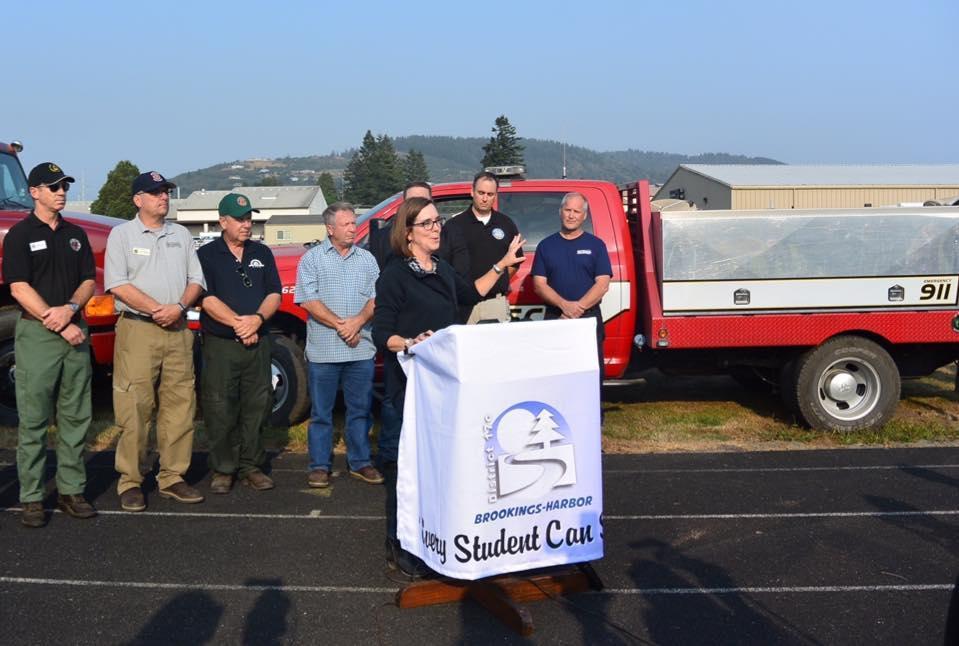
Image: Oregon Gov. Kate Brown leads a press conference on the Chetco Bar Fire from the Brookings-Harbor High School track. (Nancy Raskauskas-Coons/BHSD 17C)
The Start of School
The day for school starting was getting close, and the fire was only 10 percent contained, most of the containment was on the line closest to the northern part of Brookings only three miles away and two ridges to the east. The fire crews hit this portion of the line hard in fear of another “Chetco Effect” which would have blown the fire directly into the city. Fortunately, it never materialized. Evacuation routes were limited for Brookings — going west would end up in the ocean, east was towards the fire — it was either north or south. If this fire flanked the community, evacuation routes could be limited to one, or none.
Shelter in place became a stark reality for those that needed to stay for responsibility reasons. The school district’s admin/directors team even briefly talked about sheltering themselves and their families in the school district if needed. Starting school with staff and students wasn’t even an option at this time — many staff members were evacuated, and a large percentage of them had left the community for locations where they could stay with family members and friends.
These facts, most certainly influenced the district’s decision to delay the start of school by one week. “If we tried to start on time, we would not have had enough staff to properly care for our students and we didn’t even know how many students would be present. However, we recognized that the need existed for those that needed not only educational, but social services, and therefore looked to minimize the delay as much as possible,” Gallagher said.
Evacuation orders surrounded Brookings from mid-August, until mid-September. Anyone living outside of town, which included thousands of homes, were under at least a level 2 evacuation orders, or a level 3, which meant immediate evacuation. Citizens were spray painting phone numbers on the hind haunches of livestock and sending them to be boarded elsewhere (read more about the livestock evacuation here), those that were able to stay in town with friends and/or relatives were fortunate, others simply left for other communities throughout the Pacific Northwest to stay with family and/or friends. The school district even allowed a few teachers who did not have any family or friends within the community stay in their classrooms. “Sometimes you simply have to bend the rules for the sake of humanity,” Gallagher said.
When school finally resumed a week late, it started the year with 100 percent of our local teachers, staff in students still in a level 1, 2 or 3 evacuation zones, and some students still living in emergency shelters, such as the one at Tolowa Dee-ni’ Nation, just south of the Oregon/California border. (Read the story of the Tolowa Dee-Ni Evacuation Center here.)
Air Quality Concerns
The smoke was oppressive throughout the summer. The school district’s Athletics and Activities leadership was making decisions about whether to hold summer practices on a hour-to-hour basis due to the quickly changing air quality. Many practices were moved to Crescent City, California, about a 30-minute bus ride to the south where sea breezes were helping keep the air over their school grounds clearer than in Brookings.
The resumption of school created additional air quality concerns. The school district formulated an air quality team that included the school nurse, athletic director, and public information officer to make the best use of the information available from these sources and direct observations on our campus. The district followed all air quality guidelines published by Oregon Health Authority (OHA) and Oregon Schools Activities Association (OSAA). Notices were sent out to staff when air quality was poor with clear instructions when outdoor recesses and activities must be curtailed or canceled.

Image: Heavy smoke covered the towns of Brookings and Harbor for many days, extending in the fall. (Nancy Raskauskas-Coons/BHSD 17C)
Lasting Impacts
Brookings-Harbor School district ultimately received a waiver from the Oregon State Board of Education for the missed minutes of instructional time due to the delay to the start of the school year caused by the fire emergency. The decision was made in consultation with the local school board and union (the Brookings-Harbor Education Association), and turned out to be the right call to minimize negative impact to the school district and community. The district teachers and staff were held harmless, and received full salary or benefits despite the delay. The schools were prepared to adjust curriculum and schedules as needed to uphold rigor depending on whether or not the waiver was granted, so the students were not shortchanged. In spring 2018, the district saw another significant jump in its graduation rate, which has been on the rise in recent years.
Starting in the 2018-19 school year, BHSD will see a significant increase in instructional time over past years at all grade levels, which is beneficial for students and will also provide a greater buffer for future emergency closures or cancellations of school. The incident has also led to a re-examining of the district’s safety plans and protocols, and strengthened its network of regional emergency contacts.
“As fire season stretched on in 2017, our community saw similar situations end in tragedy for communities such as Santa Rosa, California; and Ventura County, California. A year later, we have seen the more than 1,000 homes burn in Redding, Calif., with the Carr Fire. Our hearts are with those communities, as they start their own rebuilding processes after fire. This is an event that people in our community and others are still dealing with emotionally. All schools need better resources to help students deal with the type of terror, trauma and post-traumatic stress produced by an event of this magnitude,” Gallagher said.
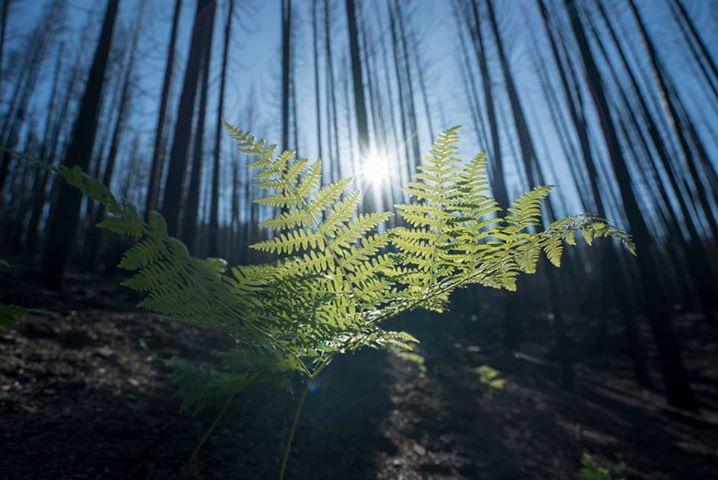
Image: New growth emerges after the fire. (Source: Dev Dharm Khalsa/Inciweb).
In the end, the community of Brookings and Harbor was saved. One rural neighborhood burned, but no lives were lost. The “Chetco Bar Fire” burned over 191,000 acres (~279 square miles) and was still only 97% contained by November 1, 2017 after 9+ inches of rain had fallen in the region. The fire will leave a long healing scar, but the most tragic consequences were avoided thanks to the efforts of thousands and a little bit of luck with the weather.
“I hope and pray that something like this is not repeated, but I am fearful it will somewhere, sometime, and somehow. We will take the lessons learned through this ordeal to improve our school district and emergency procedures in the future — and encourage you to take the time to talk with your school community or organization about what you will do when disaster races toward you,” Gallagher said.
About
Sean Gallagher is Superintendent for Brookings-Harbor School District 17C. At the time of this fire, he was starting his 27th year in public education in the State of Oregon. A former high school / community college teacher, high school principal, and 13 years as a Superintendent, he described this event as the most invasive and frightening event to public school district operations and the safety of students, staff, and community that he has ever experienced.
This story was a contribution to the Chetco Bar Fire Series from Sean Gallagher, Superintendent for Brookings-Harbor School District 17C and Nancy Raskauskas-Coons of Brookings Harbor School District 17C.
Opening Image: The sun emerges from the dense smoke plume produced by the Chetco Bar Fire in August 2017 to be visible for just a few minutes over the Pacific Ocean before sunset. (Nancy Raskauskas-Coons/BHSD 17C)
Chetco Bar Fire Stories: “Our Town Thanks You!”
“Our Town Thanks You!”
During the height of the fire, in early September, a colorful, hand-painted “Thank You Firefighters!” sign showed up on the edge of Kevin Roeckl’s property next to a road, and that, he says, is what started it all.
“After I saw that first sign, I started noticing them everywhere,” Kevin explained. He saw handmade signs in his own neighborhood on Cape Ferrelo Road. He spotted a sign done in glitter on the Chetco River bridge in town, and one next to Hwy 101 in Harbor surrounded by small lights powered by a battery taped on the back. He even noticed signs obviously done by kids and taped up in their bedroom windows on residential streets. Many local businesses had “thank you” signs in their windows or on their marquees. Kevin saw several cars with hearts and messages of appreciation painted on their windows and tailgates.
Kevin was so touched by the outpouring of gratitude toward those who were helping fight the fire, he spent an afternoon driving around and photographing every sign he could find. “Some were fancy, some were plain”, he says, “People got out their markers and their paints and stickers, little flags, ribbons, pipe cleaners. Drew pictures of firetrucks with stick figures spraying water on giant flames. The lettering was crooked and sometimes misspelled, but that just made them all the more beautiful.” Kevin thought, “I want all the firefighters to see these.”
Examples of handmade signs around the Brookings area posted by Kevin Roeckl on the “Our Town Thanks You!” Facebook Page:
A Facebook Page is Born
“People wanted everyone helping our town to know how much they were appreciated,” Kevin said. And what better way to do that than through Facebook. That’s how the Facebook page “Our Town Thanks You!” was born. Although he had never created a Facebook Group before, Kevin set up the Page, put the word out, and invited members of the community to post pictures of the signs they had made or saw in their neighborhoods. People loved it and “Our Town Thanks You!” quickly grew to hundreds of members.
Kevin did a lot of outreach to the firefighters to let them know that the page existed and to ask them to join and share with their families. He printed handouts that he gave to the National Guardsmen and asked them to pass out. He used the “Our Town Thanks You!” page to help spread the word about the “Firefighter Salute” on Highway 101, organized by Allison Thomas and held in the mornings and evenings (when fire crews came on and off duty) two weekends in a row. Many photos and videos of the cheering, sign-waving crowds lining the sidewalks during the Salute were posted on the page afterward.
The Lunch Bag Project
Kevin also used the “Our Town Thanks You!” page to help spread the word and share photos of the hundreds of hand-painted lunch bags that were handed out to the firefighters. Rene Moulton organized the lunch bag project. Bags were decorated by all three Brookings schools, at a “kids’ day” at Oxenfre restaurant, and by patrons of Chetco Brewing Co. “The goal was to make sure every single one of the 1,400 firefighters fighting the CBF got their lunch in a hand-painted bag telling them how much they were appreciated.”, Kevin said, “There were even some bags decorated in Spanish for the Hispanic firefighters.”
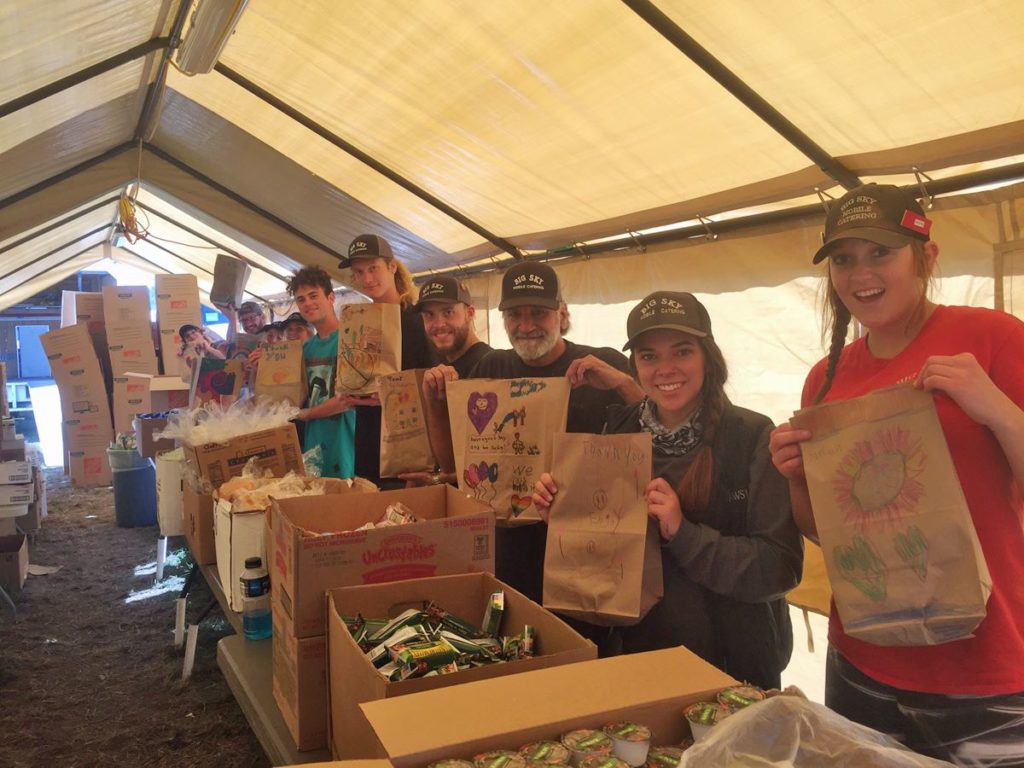
Participants display bags as part of the lunch bag project. Photo posted to the “Our Town Thanks You!” page.
Sharing the Gratitude
Kevin said that he was happy to see residents posting on the page, but he was really thrilled when firefighters and their families started joining and commenting. “That was my main goal,” Kevin pointed out. “I wanted everyone fighting the fire, from the staff at the fire camps to the firefighters and incident commanders – AND their families – to see all the love and appreciation that ‘Our Town’ felt for them!”
The “Our Town Thanks You!” page is still up, and still gets visits from time to time. One of the Public Information Officers (PIO Mitch Ward) even used some of the pictures to create a video which showed the fire – and the community – from his perspective (see the video below).
Keven Roeckl was interviewed on June 25, 2018 by Kathleen Dickson. Thank you to Kevin for making this story possible.
Chetco Bar Fire Stories: Support from Port Orford and Beyond
Support from Port Orford and Beyond
During the Chetco Bar Fire, Curry County saw an outpouring of support from outside the immediate area. Jeff MacFarlane, owner of Camp Blanco RV Park in Port Orford, was part of the team who led the effort to get donations where they were needed; his focus was on the donations coming from North Curry, Coos & Douglas counties. This is his story…
Jeff had gotten into the habit of checking Facebook for reports about the fire when, sometime in late August or early September, he started to see posts about the Food Bank running low on food due to extra demand. “I was pretty familiar with wildfires,” Jeff said, “from living most of my life in Northern California where they happened close by and frequently (like the Fountain Fire near Redding) and I wanted to do something to help the folks in Brookings.”
Jeff continued, “I thought to myself: ‘I’m self-employed; I have a truck and a teenager I can put to work; I have access to a trailer; my location is perfect [Camp Blanco RV Park fronts highway 101 and is within Port Orford city limits]…how could I NOT do something?’”
Challenging Others to Donate
So, he started up the Port Orford Chetco Bar Fire “donation challenge”. He posted the challenge on the North Curry News & Views Facebook group page, asking everyone in Port Orford to bring donations to his location, which he planned to deliver down to Brookings once he had a full load. He got permission from the local fire chief to use the county emergency response trailer, which he then parked in the middle of his RV park; had his friend, Julie Ells, make some signs; and was immediately overwhelmed with the amount of donations that started pouring in.
“I mean, I KNEW some people would help,” Jeff said, “but I was really surprised at the level of it all; at one point, I remember there were 8 trucks lined up to help deliver donations to Brookings, we were getting so much help!”
No System In Place
As echoed in many of the interviews for the Chetco Bar Fire Series, Jeff noted that there really was no organized system in place to coordinate all the donations. A system had to be developed as they went along. Everyone wanted to help, but the lack of a system made it a challenge. Jeff basically decided on his own to be “the one doing the gathering,” as he put it.
That meant Jeff became the main hub for all donations coming from the north. This included Port Orford and Langlois; Coos County (Joni Wasson had a food drive going at the Fred Meyer in Coos Bay; another lady from Coquille – Lisa – started collecting food at the McKays there); basically, everything coming from the north. Jeff became acquainted with Summer Matteson and Andre Bay, neither of whom he’d known prior to the donation effort. Jeff would report to them what he had coming in from North Curry and points north; Summer and Andre would then tell him what was needed, and when and where it was needed.
Many Generous People; Many Helping Hands
Brett Webb, commercial crab fisherman, friend, and Port Orford city council member (“…who actually started working on this before I did,”Jeff said) was instrumental in getting permission to store the excess food and other donations at the Port Orford Community Building until they were needed in Brookings and could be transported. Dave Duncan, Port Orford fire chief, approved the use of the Curry County emergency response trailer that Jeff parked at his campground.
Jeff’s friend, Andy Juell, took some of the truckloads down, as did others; his camp host, William, helped organize the donations that were brought to Camp Blanco. Jeff and others would go north with empty trailers, fill them up with donations, and deliver them down to Gold Beach, Brookings, and Smith River.
And The Donations Poured In
“People I didn’t even know were making donations,” he went on. “Even my son’s girlfriend, Lacey Smith, who’s a bartender at Pitches, announced that they would donate a week’s worth of tips to the cause; she ended up collecting over $1,000 to send down to the Chetco Bar Fire fund at Wild Rivers Community Foundation!”
Jeff continued, “From start to finish, I believe our local team and I were able to collect and deliver just over 10,000 pounds of mostly food, some water, and a few other items like blankets, pet supplies, toiletries, and other household goods.”
“Everybody in Port Orford wanted to do something, it wasn’t just me” Jeff explained. “People would come into the RV park, literally put a wad of cash in my hand, and say ‘give this to the folks dealing with the fire’. They knew just like I knew…this could very easily have been us needing the help.”
Jeff MacFarlane was interviewed by Kathleen Dickson on Feb. 5, 2018. Thanks to Jeff for making this story possible. Thanks also to Brian Tillung for generously contributing photos for this story.
Chetco Bar Fire Stories: The Tolowa Dee-Ni’ Nation
Housing for the Evacuees: The Tolowa Dee-Ni’ Nation
Many acts of random kindness were on display during the Chetco Bar Fire, generous gestures that defines what community is about. Organizations, businesses and individuals all stepped up and gave of their time, money, resources and many opened up their homes. Noteworthy in the coordination of efforts for the larger community was when the Tolowa Dee-ni’ Nation, Brookings’ Smith River neighbor to the south opened up the old Ship Ashore property to all evacuees of the Chetco Bar Fire.
An interview with Tessa LaFazio, who took on the herculean task of coordinating operations of the temporary evacuation shelter- before, during and after, gives a picture of the many people that came together under trying times.
When the Chetco Bar Fire swept out of control in August, 2017, staff of the Tolowa Dee-Ni’ Nation sprang into action upon learning that large numbers of people and their trailers or RVs were being displaced. Tessa LaFazio, the Emergency Services Specialist for the tribe, realized that immediate housing and spaces were needed for the RVs and trailers being evacuated from RV parks affected by the fire. Many were permanent residents that were being uprooted. The Ship Ashore property in Smith River, recently acquired by the Tolowa Dee-ni’ Nation, was quickly prepared to receive the expected influx of evacuees from the fire.
The logistics of this large emergency shelter endeavor were challenging- mapping out the placement of trailers, RVs and tents as well as physically setting up their locations, developing and implementing a checking in/out process, setting up a dorm building, beds, showers, bathrooms, maintenance, security and of course, how to feed everyone. Tessa and her crew went to work.
Fortunately, since many evacuees had their own trailers or RVs to prepare meals in, the number of meals that needed to be served were not as large as it could have been. Also, for the first eleven days the Red Cross provided funding so that two of the three meals could be prepared by the Tribe’s House of Howonquet Restaurant. After that, tribal staff and volunteers cooked and served. Neighboring churches in Smith River took their turns, as well as did tribal staff and people staying in the shelter. There was a feeling of camaraderie and community during those mealtimes that the shelter was open by the Tribe.
For Tessa, those shared feelings of community and thankfulness from the evacuees, as well as knowing that she was doing the right thing for everyone helped buttressed her during those many twenty hour days during the four weeks the evacuation shelter was open. Community support, donations and volunteer time were given from the many local businesses and people from the surrounding communities. Over 110 volunteers put in countless hours at the evacuation shelter from Curry and Del Norte counties, Tribal council members and staff donated their time. Local businesses such as Alexandre Dairy, Rumiano Cheese and Java Hut, as well as Fred Meyer donated food and supplies. Agencies brought a mental health volunteer to the shelter to help those affected by the fire.
Over 140 evacuees were served at the Tribe’s evacuation shelter. It was the only shelter open consistently for any persons evacuated during that time. Of great importance for many of the evacuees, was that they were able to keep their pets or animals with them, since many of them were in their RVs or trailers.
For almost four weeks, services of indoor shelter, RV sites with water and sewer hook-ups, tent sites, prepared meals and snacks, laundry facilities and restrooms with showers were provided at this evacuation shelter by the Tribal Nation.
When asked how the experience of those four weeks and its aftermath affected her, Tessa shared that she had a better understanding of herself, her strengths and weaknesses, personally and professionally, and of her community, as well as a deeper appreciation of it.
There were also lessons learned. “It was a learning experience for everyone,” stated Tessa. “ Emergency Preparedness cannot be on the backburner.” Better communications between local governments such as the Tribal Nation and Curry County as well as with agencies such as the Forest Services were also identified as areas for improvement. Communication at all levels was the biggest challenge for many. Information was hard to come by for the evacuees until the Forest Service was later brought in for updates.
The valuable insights realized in the process of providing an evacuation shelter, as well as the impacts of the Chetco Bar Fire has the Tolowa Dee-ni’ Nation proactively working to be better prepared for whatever crisis may next come their way.
Thanks to Tessa LaFazio for sharing the story about the Tolowa Dee-ni’ Nation’s Ship Ashore evacuation shelter, and to Jeri Lynn Thompson, Tribal Council member and Tribal Secretary of the Tolowa Dee-ni’ Nation for making this possible.
Chetco Bar Fire Stories: Volunteers Undertake Resource Coordination Effort
Volunteers Undertake Resource Coordination Effort
Summer Matteson-Kinney works as the Curry County Juvenile and Parks administrator, but little did she know that during the Chetco Bar Fire, she would become the lead team member for the Chetco Bar Fire Donation & Volunteer Resource Coordination Team.
It started as Summer was camping over the weekend of August 19 with friends and family. She began getting texts about donations coming in for fire evacuees, “first from Brandy Haselden [Neighborworks Umpqua], then from [State Representative] David Brock Smith,” Summer Matteson-Kinney explained. “Of course, I had no idea the fire had blown up like it had, until I got back home Sunday [August 20].”
First thing Monday morning, August 21, Curry County Sheriff John Ward came to ask Summer if she would head up the coordination of volunteers and donations. “Of course, I didn’t think to ask what it was going to entail- I just said ‘yes’, “ she explains.
Reaching Out For Help
Summer knew she was going to need some help, so the first person she reached out to was Andre Bay. “He and I had worked together during some recent search and rescue efforts,” Summer said, “plus he was a friend; I knew he was well connected and would probably be willing to help.”
Summer continues: “ I also called Karen Layng [with the state OEM/FEMA office], who basically told me to ‘start on page 16’ of the FEMA handbook; so that’s what we did!” OEM’s (Offices of Emergency Management) from other states began to offer their help and resources as well.
Summer went on, “Well, that ‘yes’ back on the 21st turned into seven weeks of volunteering during every spare hour I had – vacation time, lunch hours, before work, after work…even weekends – because that’s what it took to stay on top of what became a massive coordination job for me and the other members of our core team.”
Andre’s Connections
“Summer’s the one who got me involved,” Andre Bay explains, “She called me the same day the Sheriff called her to be the donations coordinator. Summer and I had worked together on search and rescue missions, and she knew I was someone who could make things happen.”
Andre continued, “Well, the first thing I did was gathered info. Basically, I hit the streets, stopping in parking lots, for instance, looking for folks displaced by the fire who were temporarily living in their RVs, to find out what their immediate needs were. I drove from Gold Beach to Ship Ashore, just checking with everyone I met, asking them how we could help.”
The Core Team Is Formed
A donation and volunteer coordination team was formed. The coordination team was: Summer (government services); Andre Bay (food); Allison Thomas (press releases, manned the Remax locations); Tami Bishop (defensible space); and Jeff McFarlane (north county donations). Summer put together handbooks that each team member used and that included all the resources they had available at any given time. The team was in contact daily, varying between face-to-face, or by phone, text, Facebook Messenger, or email, and Summer acted as the “central” hub regarding any decisions the team made, because she answered to the Sheriff.
The Chetco Bar Fire Help (CBFH) page, originally started by Ryan Hanners, became a central hub for most of the donations and volunteer offers. The coordination team would get word for a need through the CBFH page, or via a Facebook “private message”, or by phone; volunteers were connected to needs via the CBFH page and were put on the list for future help.
The team served all the Curry County food banks during the fire, as well as Oasis Shelter. They also delivered a few tons of food in person to the families on Cate Road. The Elks opened their door to the team so they could offer a free clothing store there for evacuees.
The Three Percenters Answer The Call
Due to a lack of resources in Curry County, Andre decided to reach out to his contacts throughout the region who were part of “Three Percenter” Groups. (The Three Percenters (also styled 3%ers and III%ers) are people who “stand up for people’s rights,” according to Andre: they are community-driven, self-sufficient, and non-violent; come in response to calls for help; and are there to help in whatever way they can, he explained.
“We had volunteers showing up who came from Three Percenter groups in Seattle, Portland, Salem, Lebanon and Redmond, Lincoln and Lake Counties, Del Norte County, and right here in Curry County to do whatever they could to help out,” Andre explained, “they sent people, food and emergency supplies; they helped folks clear their property to prepare it in case the fire came their way; they put on a barbecue at the Old Fireside Diner in Harbor to raise money; they were “boots on the ground”; and many of them stayed as long as they were needed, even at the expense of their own lives and families.”
The Three Percenter volunteers helped clear 56 properties located in Level 3 Evacuation areas in Curry. They moved their resources to O’Brien (Josephine County) to help out over there when the fire started moving in that direction, and after it had calmed down in Curry County.
Keeping Track Of It All
From the start, Summer made sure to track donations and volunteer hours, but because the donations had to be accounted for through either a nonprofit or government entity, she needed help. She went first to the Curry County Board of Commissioners, but they didn’t have the resources or capacity to help much. The Rotary Club was willing to help, but wasn’t ready to support an online effort. That was when Wild Rivers Community Foundation (WRCF) offered to be the hub. Jessica Carrillo helped by keeping track of where stuff would go and monetary donations went directly to WRCF, with Michelle Carrillo’s help.
WRCF also organized a meeting, facilitated by Geri Livingston, that brought stakeholders together; the goal was to figure out what was needed and who could supply what. The result was a better ebb and flow of supplies, resources and volunteers, according to both Summer and Andre.

Donations arrive from a group in Redmond. Andre is on the left, Summer is third from left, in the back.
And The Donations Poured In
Andre estimates they moved approximately 45,000 pounds of food and supplies between the Brookings Harbor Food Bank and the storage facilities that Marie and Bret Curtis with ReMax opened up for them. The Harbor Remax office was also where one of the Chetco Bar Fire “free” stores was located (the other was at the Elks Lodge), where people could come get what they needed from the piles of donations that kept pouring in.
Monetary donations were mostly directed to Wild Rivers Community Foundation, but that money was not immediately available, as it had to be “passed through” a nonprofit before it could be accessed, which took time, Andre said. When the Nazarene Church agreed to act as the pass-through nonprofit for immediate needs – what Andre called the “Cate Road fund” (i.e. donations gathered by the team and meant to fund immediate needs for those who lost their homes on Cate Road) – that was “a Godsend” as Andre put it, as the church was able to make the money more easily accessible.
Challenges Identified
Summer and Andre both identified a lack of resources and limited government support as major challenges during the fire. It was immediately obvious as well that Curry County needs to institute a Volunteer Organization Active In Disaster (VOAD), or a Community Organization Active In Disaster (COAD). Shelter and temporary short-term housing was in very short supply. The Red Cross didn’t understand our local needs, according to Summer, so the shelters they set up were little used. At Ship Ashore, they had a better handle on what the evacuees needed, she felt.
Andre is still working on relief, advocating mostly for the families on Cate Road who lost their homes and infrastructure. He said they (he and Summer) personally delivered checks on Nov. 18 – just before Thanksgiving – to those families that came from donations raised at a fundraising concert in September with the Kingston Trio.
Was There Any Good To Be Had?
When asked if there was anything good that came out of the experience, Summer smiled and said, “You’ve seen the bumper stickers floating around since then, right? The ones that say ‘Curry Strong’? Well,” she continued, “that bumper sticker says it all: we’re strong – as a community, as a county, as a region. We showed that we know how to take care of our own.”
Summer Matteson-Kinney was interviewed by Kathleen Dickson on Nov. 28, 2017, and Andre Bay was interviewed by Kathleen Dickson on Dec. 5, 2017. Thanks to both Summer and Andre for sharing their stories.
Chetco Bar Fire Stories: A Community Steps Up to Feed Fire Evacuees
A Community Steps Up to Feed Fire Evacuees
The Brookings Harbor Food Bank was at the forefront of disaster relief during the Chetco Bar Fire. People were displaced all over the region, temporarily relocating to Gold Beach, Port Orford, and Crescent City; many who were regulars at the food bank were all of a sudden missing.
“I was at meetings in Medford when the fire started moving [just before the weekend of August 19],” Pamela Winebarger, Executive Director for the Brookings Harbor Food Bank related, “and I’d only been on the job here since April, so at first, I thought we were on our own.” She continued, “Thankfully, we were not. Donations AND volunteers started pouring in from all corners of Oregon and California.”
These donations were crucial. In August alone, the numbers at the Food Bank went from a normal 1800 people helped to over 4300; the need tripled. The Brookings Harbor Food Bank started handing out weekly boxes (instead of the normal monthly ones) and stopped requiring income verification – anyone who needed food during the crisis got some.
Support Came From All Sides
The Food Bank started seeing all kinds of donations. “A truck was loaned to us for additional storage,” relates Pamela, “a real estate office offered two locations at which to store extra donations; food drives were conducted by a number of nonprofits; the overwhelming generosity just blew me away!”
Donations kept pouring in. Two weeks into the evacuations, Debbie with the Salvation Army handed them a purchase order for $2,000 to Ray’s Market in Gold Beach. They used it to buy meat for the folks affected by the Chetco Bar Fire. The Oregon Employee Association sent a check; the Crescent City Emblem Club donated 3100 pounds of food and $170 from a food drive they conducted outside Walmart. Ryan Wheelock, a business owner from Klamath Falls, got together with other people in the community and brought 3,875 pounds of food and water in a U-Haul, simply because he wanted to give back.
Hal & Lori, owners of Grocery Outlet, donated 19 pallets of water (individual bottles AND gallon containers, valued at $5,000 total) that had been delivered to their store accidentally. Their corporate office told them, “give it away”, so they did…to the Food Bank. Within 4 hours, all but one pallet was gone. Food drives were conducted at the Dollar Store and BiMart; donations came in from Grocery Outlet, Fred Meyers, South Coast Food Share, and the Oregon Food Bank. A lady came in one day and donated her last $10.00; a young girl baked and sold cookies and donated the $56.00 proceeds.
“It was a very intense, but good, ‘fuzzy’ feeling,” Pamela went on to say, “A lot of people gave because they could…but many people also gave because they felt they should.”
“Thank goodness for our Food bank manager, Carolita Briggs, and the 18-20 other volunteers who pushed themselves all of August and September, during the worst of it,” Pamela explained, “they were a Godsend, and I had to be constantly making sure they would take a break and not push themselves so hard!”
Communicating Needs
Pamela did numerous interviews on the radio stations and for the newspapers, and the word got out that donations were needed – “it eventually took on a life of its own”. For instance, three weeks into the evacuations, a tattoo artist in Bend contacted Pamela on a Sunday, wanting to know where to bring 3600 pounds of food they wanted to donate; Pamela had no idea where she learned about the disaster.
The Facebook page “Chetco Bar Fire Help Page” became the central hub for all offers of food, money, and volunteers. The Food Bank became the gathering place for all the food donations. Pamela was concerned that donations might be getting diverted away from the other food banks, community kitchens and food pantries in the region, so she checked on them regularly to make sure they had enough for their people, and shared what the Food Bank had when others needed it.
Lessons Learned for the Future
There were a number of lessons learned during the crisis. For instance, Pamela noticed there was a real need for collaboration between the various government entities (e.g. the sheriff’s office) and those nonprofits offering services to evacuees and others. The Wild Rivers Community Foundation helped address this need by organizing a meeting at the Chetco Activity Center to pull together all the people working on relief efforts. Collaboration started happening. Pamela attended the meeting and because of connections made there, she was able to reach out to volunteers to come help receive the food, find a place to store it, and then parcel it out to where it was needed most.
The Chetco Bar Fire also revealed a definite lack of temporary housing for evacuees; a lack of daycare also became apparent when childcare providers were themselves evacuated, leaving parents with no options. Pamela also noticed that our region lacks a centrally-located “informational” sheet that lists what services are available – for both during and AFTER a crisis is over. The good news, many of these are deficiencies that can be addressed.
A Very Giving Community
All in all, the Chetco Bar Fire was an eye-opening experience for Pamela. “Before the fire, I had been volunteering at St. Tim’s,” Pamela said, “and I saw how much need there was here. What I hadn’t seen yet was how generous this region really is. During and after the fire, I realized we live in a very giving community, full of people who do what needs to be done, often without any fanfare or thought for their own needs,” she continued, “They saw what I saw: that those who were being evacuated were oftentimes not well off, and it wasn’t so easy for them to just leave their homes and stay somewhere else for weeks on end. They needed our help.”
Pamela Winebarger, Executive Director of the Brookings Harbor Food Bank, was interviewed on Nov. 27, 2017 by Kathleen Dickson. Thanks to Pamela Winebarger, for making this story possible. Read more about the Brookings Harbor Food Bank here as part of our Wild Rivers Connect Positive Stories Series.
Chetco Bar Fire Stories: A Safe Place for the Animals
A Safe Place for the Animals
On August 19 Ruth Leming Dixon, 4-H Educational Program Assistant in Gold Beach, had just started a week of vacation. She was horseback riding with her friend and 4-H leader, Megan Boardman, when Megan received a text message asking for help evacuating horses off Gardner Ridge. Ruth went along to help.
Little did she know, this was just the beginning.
That first group of horses was able to go to private pastures in and around Brookings. But by 3:00 a.m. on Sunday morning, August 20, the need to open up the livestock pavilion at the Curry County fairgrounds became apparent. Ruth explained, “That was when we got the call that one family’s entire menagerie needed to be evacuated – 15 hogs, 2 goats, and an unknown number of chickens, geese and pigeons!”
Ruth reached out to 4-H alumni, and those with trailers agreed to meet at the bottom of that family’s mountain road. “Because the driveway wasn’t big enough for all of us to go up, load, and turn around, we left the rigs at the bottom and went the rest of the way on foot. We decided to take the pigs that night, and the owners would transport the other animals once the sun came up. The volunteers and owners then walked the pigs down to the trailers… it was quite a sight to see in the glow of many flashlights!”
Ruth wasn’t the only one evacuating livestock in the dark that weekend.
Herding a group of piglets – one small one tucked under her arm – as she led the 500 lb. mama pig down a long, dark road with bits of grain was not how Michelle Carrillo had envisioned her weekend turning out. But there she was, at 3:00 a.m. on that same dark Sunday morning, leading her group of mama pig and piglets down the mile-long road to trailers to transport them to safety.
Where do we TAKE all these animals?
The rescuers quickly realized that they needed a place to put all these animals, so they tapped into their network. “One of the folks helping that Sunday was Rob Carrillo, a board member for the county fairgrounds in Gold Beach, so he made an executive decision to let us open up the livestock pavilion right then,” Ruth explained, “And it basically took off from there. Before we knew it, we were in the business of coordinating the evacuation, housing, feeding, and keeping track of, just about every cow, horse, goat, pig, chicken – even some dogs and cats – in and around Brookings that needed our help while the Chetco Bar Fire raged on!”
Ruth became the lead for evacuated livestock, horses and pets, not only those brought to the Curry County Fairgrounds during the fire, but those brought to private pastures and, later on during the emergency, those who went across state lines to the Del Norte Fairgrounds in Crescent City.
Coordinating It All
Most of this coordination took place by phone or via a Facebook page set up by 4-H Alum Jessica Altore called “Chetco Bar Fire Livestock, Horses & Pets.” Jessica, Chris Brose, and Ruth acted as administrators for the page. (The page still exists, but with a new name now: “Curry County Horse, Livestock & Pet Disaster Support”.)
Ruth volunteered throughout her week of vacation, and then continued to coordinate from her desk at the Curry County Extension Office. She continued volunteering after work hours.
Ruth wasn’t alone. “My friends, 4-H contacts, and the livestock community rallied around each other and made this massive animal evacuation work,” Ruth explains. ”We all knew that folks just were NOT going to get themselves safe until they’d made sure their animals were, so we pitched in to give them that reassurance.”

Annaliese Carrillo helps with evacuated chickens at the fairgrounds. Photo courtesy of Michelle Carrillo.
Many Helping Hands
Brittany Scott, a 4-H member, stayed overnight in the Curry County Fairgrounds livestock pavilion with the animals for 24 days straight. (See video from The World of Brittany Scott at the end of this story). Trish Jordan, a 4-H leader, came down from Bandon and assisted. Gary Hoenie, one of the maintenance personnel at the Curry Fairgrounds, helped out wherever he could. Ryan Scholz, the ODA district veterinarian, helped Ruth work through the rules needed to get horses across the California state line, and was the one who suggested Ruth look into obtaining resources from Curry County. Coos Forest Patrol employees Brett Weidemiller and Justin Coleman, along with their crews, were a huge help at the pavilion, setting up, cleaning, and breaking down stalls. Douglas County loaned Curry County their Community Emergency Response Team (CERT) animal trailer for the duration of the emergency.
By the second week, Retired Emergency Services Manager (ESM) Don Kendall stepped in to help, along with Sherrie Ward (from the County ESM office). Wild Rivers Community Foundation and Michelle Carrillo helped Ruth direct donations for the animals where they were needed. Donated or discounted supplies came in from companies like Bandon Feed & Rescue, Gold Beach Lumber, and Colby at Troxel Hay Sales.
The Challenges
This massive livestock evacuation did not come without challenges. Animals would sometimes come in without any owner info, making it really hard to keep track of them while they were being cared for. Ruth also mentions that their coordination could have been smoother had they started out using digital media, rather than putting sticky notes all over the place; more back-office support would have been useful as well.
Ruth noticed that it was hard to keep the momentum going after the crisis was over, which could make it a challenge to be prepared the next time a disaster hits. It also would have helped to know what resources – financial and otherwise – were available before they were in crisis mode. With that said, many lessons have been learned. “At least now we know we need a CERT animal training for the next crisis,” Ruth said.
Preparing for the Next Time
Michelle Carrillo also noted that relocating livestock to various locations for safe keeping basically worked out. However, this was a wake-up call as to how ill prepared we were as a community for an event of this nature. In her opinion, there need to be community plans for the removal of animals or livestock to designated shelters, as well as the care and feeding of them.
Fortunately, this time, it was the local knowledge and connections of volunteers like Ruth and Michelle who could find landowners willing to accept these animals at a moment’s notice, as well as the network of 4-H members with the experience, skills, and trailers that could round up and transport them to safer locations, that made everything work.
Community Values
Despite the gaps and challenges, Ruth came away from the Chetco Bar Fire with a sense of reassurance that people will help one another…AND their animals. “I watched our communities – all of them – draw together, and that did a lot to reassure me that we would take care of each other in the event of another disaster,” Ruth said.
The experience of being a part of the immediate call to action, seeing so many people showing up to help, and just getting things done, also gave Michelle a “re-grounding” in the value of basics. The basics of just rolling up your sleeves and helping, “dropping all the crap” that gets in the way of kindness, and knowing that your community is there. Those feelings still uplift her today.
Ruth Leming Dixon, 4H Educational Assistant, was interviewed on Nov. 20, 2017 by Kathleen Dickson. Michelle Carrillo, Building Healthy Communities Director (and former 4H Director) was interviewed by Georgia Nowlin. Thanks to Ruth and Michelle for making this story possible.
See Brittany Scott, 4-H member and 2017 Gold Beach High School graduate, in a video created by The World, and read more about her story here.
Introduction to the Chetco Bar Fire Story Series
Introduction to the Chetco Bar Fire Story Series
The Chetco Bar Fire erupted towards the Oregon Coast on August 18, 2017. It began as a small and slow-moving fire in July, until hot, dry winds, known locally as the Chetco Effect, arrived on the evening of August 15. Everything picked up after that: on August 17, the fire jumped the Chetco River’s South Bank and reached 8,500 acres in size. Over the next few days the fire would blaze across 18 miles in 80 hours. On August 20, the Oregon State Fire Marshal activated the Conflagration Act. Fire fighters came pouring into the area to fight the fires, boosting numbers to 1,174 fire fighters, from 280 two days earlier.
Before all was said and done, the Chetco Bar Fire would torch 191,125 acres, burn 6 houses, cause the evacuation of more than 5,000 people from their homes, and expose thousands more to hazardous smoke.
Many of us listened and watched the daily updates and fire maps as the wildfire spread closer and closer to homes around and in the town of Brookings. Heard were traumatic stories of the escalation of the Chetco Bar Fire and the herculean effort to put it out. Whether our homes were threatened or not, the many dark, acrid, smoke-filled days impacted people and activities for miles around. This disaster affected everyone in our region in some way.
But in the midst of this disaster, stories of selflessness, acts of generosity, and the many people, organizations and businesses stepping forward to give of their time, money and goods began to emerge. A strong community spirit of appreciation was kindled from this wildfire event, and was most visible in the many expressions of gratitude and thanks in display throughout the community and online. We were ALL in this together.
To capture the moments when we came together as a community to help one another, Wild Rivers Connect conducted 13 interviews with individuals involved with the relief effort during the Chetco Bar Fire, either on their own or as part of an organization. These individuals range in profession, from retiree to 4-H educational assistant, juvenile case worker to food bank director, and so many more. They live and work across the region, from Crescent City to Port Orford, and even to Coquille. Parents, friends or strangers, they showed that we were, most of all, neighbors.
These folks volunteered countless hours to meet the needs of others, many of them doing this in addition to their regular work day. They filled fundamental needs like food, water, and housing; they sheltered evacuated animals; they coordinated the gathering, storage, and dispersal of donated items; they connected those in need to resources; they did all these things and more.
At Wild Rivers Connect, we want to share some of their stories. These stories are meant to spotlight some of the incredible work done in our communities by individuals and nonprofits. They also identify gaps in services and lessons learned that must be addressed – not just before the next disaster, but that exist day to day in our communities. Each week for the next six weeks, we will be sharing one of the Chetco Bar Fire Stories with you on our website. We know that there are countless other stories out there, and we regret that we couldn’t cover every single one, but we do hope that you will share them with us and with each other.
Our thanks to those who have shared their stories with us, and to our wonderful communities.


